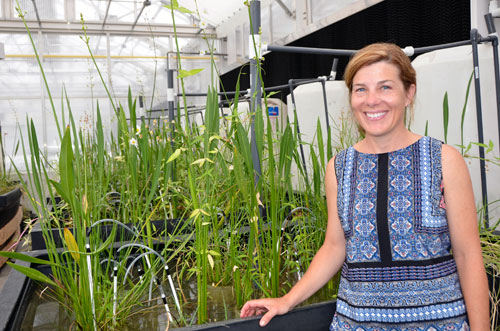Blue Carbon: A Buried Benefit for the Climate

LSU researcher Tracy Quirk.
Some 40 percent of the nation’s coastal marshes reside in Louisiana. These wetland habitats are vital to the state’s economy, ecology, resilience and, most recently, the climate.
Marshes were not always recognized for their national importance. In 1949, the federal government passed a Swamp Land Act for Louisiana designed to drain more than nine million acres of wetland habitat and convert it to more “productive” uses. These habitats were seen as “worthless”.
It wasn’t until the 1950s that there was growing recognition of important benefits derived from wetlands. They filter water, provide nursery habitat for fisheries, buffer against storms and so on. A lot of research has demonstrated how marshes benefit the state, but there is growing research on how wetlands benefit the globe through carbon sequestration.
For the past few years, Louisiana Sea Grant supported researchers at Louisiana State University have studied the blue carbon capacity of coastal wetlands. Blue carbon is carbon that is being stored long term in marine ecosystems like mangroves, coastal wetlands, tidal marshes, salt marshes and seagrass beds. By being sequestered, this carbon is not currently adding to climate change.
“These blue carbon systems are extremely productive. They are sequestering lots of carbon dioxide from the atmosphere,” said LSU researcher Tracy Quirk. “These coastal systems occupy something like two percent of the Earth’s surface, but they’re per square meter ability to accumulate carbon is quite high.”
Quirk’s lab has been looking at how and where Louisiana marshes’ store their carbon. “A lot of people define blue carbon as the carbon that’s accumulating in the soil, but it’s also the plant biomass itself.” Her close examination of salt marshes has led to some interesting findings.
First, the marshes ability to store carbon is not equal nor uniform. An original hypothesis that marsh age was the primary driver of carbon storage was refuted. As were other factors like elevation, water levels and the amount of minerals in the sediment. Ultimately, they found one marsh feature correlated with greater carbon storage – the density of the vegetation.
“High-density species, like Spartina patens, are the ones that are contributing the most to the carbon.” This species typically occupies higher elevations where it outcompetes its low-lying counterpart, Spartina alterniflora. This conclusion answered one question but raised another: What was keeping the S. patens from thriving in the newly created marshes?
“S. patens is typically the dominant competitor over S. alterniflora. Alterniflora can tolerate inundation. If you transplant S. patens to the lower elevations it will die, but at higher elevations it is a better competitor. But that dynamic is reversed if you add nutrients. Nutrient fertilization reverses the competitive dominance.”
And it turns out that these newly created marshes have lots of nutrients, which S. alterniflora was rapidly sucking up. This allows it to thrive to the detriment of S. patens. “So, these two stories which we didn’t initially think were connected, actually are. When thinking about the conditions necessary to promote high-density species, like S. patens, we need relatively low nutrient availability and higher elevations. And in those areas, you’ll have more carbon accumulation rates in this system.”
This research has obvious implications of Louisiana and its future. With billions of dollars earmarked for marsh creation, it’s of vital importance to know how to build sustainable marshes. Additionally, maintaining Louisiana marshes is of global concern for their ability to effectively sequester carbon.
“These systems are vulnerable to degradation,” said Quirk. “There’s opportunity there for us to use this science of having really high productivity and carbon accumulation rates and justifying some restoration and protection for these systems.”
